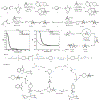Exploiting the sp2 character of bicyclo[1.1.1]pentyl radicals in the transition-metal-free multi-component difunctionalization of [1.1.1]propellane
- PMID: 35864151
- PMCID: PMC9420824
- DOI: 10.1038/s41557-022-00979-0
Exploiting the sp2 character of bicyclo[1.1.1]pentyl radicals in the transition-metal-free multi-component difunctionalization of [1.1.1]propellane
Abstract
Strained bicyclic substructures are increasingly relevant in medicinal chemistry discovery research because of their role as bioisosteres. Over the last decade, the successful use of bicyclo[1.1.1]pentane (BCP) as a para-disubstituted benzene replacement has made it a highly valuable pharmacophore. However, various challenges, including limited and lengthy access to useful BCP building blocks, are hampering early discovery research. Here we report a single-step transition-metal-free multi-component approach to synthetically versatile BCP boronates. Radicals derived from commonly available carboxylic acids and organohalides perform additions onto [1.1.1]propellane to afford BCP radicals, which then engage in polarity-matched borylation. A wide array of alkyl-, aryl- and alkenyl-functionalized BCP boronates were easily prepared. Late-stage functionalization performed on natural products and approved drugs proceeded with good efficiency to generate the corresponding BCP conjugates. Various photoredox transformations forging C-C and C-N bonds were demonstrated by taking advantage of BCP trifluoroborate salts derived from the BCP boronates.
© 2022. The Author(s), under exclusive licence to Springer Nature Limited.
Conflict of interest statement
Competing Interests Statement
The authors declare no competing interest.
Figures




Similar articles
-
A General and Modular Approach to BCP Alkylamines via Multicomponent Difunctionalization of [1.1.1]Propellane.J Am Chem Soc. 2023 Mar 8;145(9):5363-5369. doi: 10.1021/jacs.2c13298. Epub 2023 Feb 21. J Am Chem Soc. 2023. PMID: 36802571
-
Nickel-Mediated Alkyl-, Acyl-, and Sulfonylcyanation of [1.1.1]Propellane.Chem Catal. 2023 May 18;3(5):100608. doi: 10.1016/j.checat.2023.100608. Epub 2023 Apr 19. Chem Catal. 2023. PMID: 37840854 Free PMC article.
-
Dicarbofunctionalization of [1.1.1]Propellane Enabled by Nickel/Photoredox Dual Catalysis: One-Step Multicomponent Strategy for the Synthesis of BCP-Aryl Derivatives.J Am Chem Soc. 2022 Jul 20;144(28):12961-12969. doi: 10.1021/jacs.2c05304. Epub 2022 Jul 6. J Am Chem Soc. 2022. PMID: 35793500
-
Photocatalytic Difunctionalization of [1.1.1]Propellane.Chem Rec. 2025 May;25(5):e202500018. doi: 10.1002/tcr.202500018. Epub 2025 Mar 27. Chem Rec. 2025. PMID: 40143657 Review.
-
Recent Advances in Radical Coupling Reactions Directly Involving Bicyclo[1.1.1]pentane (BCP).Top Curr Chem (Cham). 2025 Jan 18;383(1):6. doi: 10.1007/s41061-025-00490-3. Top Curr Chem (Cham). 2025. PMID: 39826019 Review.
Cited by
-
1,3-Difunctionalization of [1.1.1]propellane through iron-hydride catalyzed hydropyridylation.Nat Commun. 2024 Jul 17;15(1):5993. doi: 10.1038/s41467-024-50356-3. Nat Commun. 2024. PMID: 39013909 Free PMC article.
-
Photochemical Intermolecular [3σ + 2σ]-Cycloaddition for the Construction of Aminobicyclo[3.1.1]heptanes.J Am Chem Soc. 2022 Dec 28;144(51):23685-23690. doi: 10.1021/jacs.2c11501. Epub 2022 Dec 15. J Am Chem Soc. 2022. PMID: 36523116 Free PMC article.
-
Photoredox catalysis enabling decarboxylative radical cyclization of γ,γ-dimethylallyltryptophan (DMAT) derivatives: formal synthesis of 6,7-secoagroclavine.Beilstein J Org Chem. 2023 Jun 26;19:918-927. doi: 10.3762/bjoc.19.70. eCollection 2023. Beilstein J Org Chem. 2023. PMID: 37404801 Free PMC article.
-
Borylated cyclobutanes via thermal [2 + 2]-cycloaddition.Chem Sci. 2024 Jan 25;15(9):3249-3254. doi: 10.1039/d3sc06600b. eCollection 2024 Feb 28. Chem Sci. 2024. PMID: 38425521 Free PMC article.
-
Silver-mediated formal [4π + 2σ] cycloaddition reactions of bicyclobutanes with nitrile imines: access to 2,3-diazobicyclo[3.1.1]heptenes.Chem Sci. 2025 Feb 17;16(11):4654-4660. doi: 10.1039/d4sc08280j. eCollection 2025 Mar 12. Chem Sci. 2025. PMID: 39968285 Free PMC article.
References
-
- van de Waterbeemd H & Gifford E ADMET in silico modelling: towards prediction paradise? Nat. Rev. Drug Discov 2, 192–204 (2003). - PubMed
-
- M. Honorio K, L. Moda T & D. Andricopulo A Pharmacokinetic properties and in silico ADME modeling in drug discovery. Med. Chem 9, 163–176 (2013). - PubMed
-
- Lovering F, Bikker J & Humblet C Escape from flatland: increasing saturation as an approach to improving clinical success. J. Med. Chem 52, 6752–6756 (2009). - PubMed
-
- Ishikawa M & Hashimoto Y Improvement in aqueous solubility in small molecule drug discovery programs by disruption of molecular planarity and symmetry. J. Med. Chem 54, 1539–1554 (2011). - PubMed
-
- Meanwell NA Synopsis of some recent tactical application of bioisosteres in drug design. J. Med. Chem 54, 2529–2591 (2011). - PubMed
Publication types
MeSH terms
Substances
Grants and funding
LinkOut - more resources
Full Text Sources
Other Literature Sources

